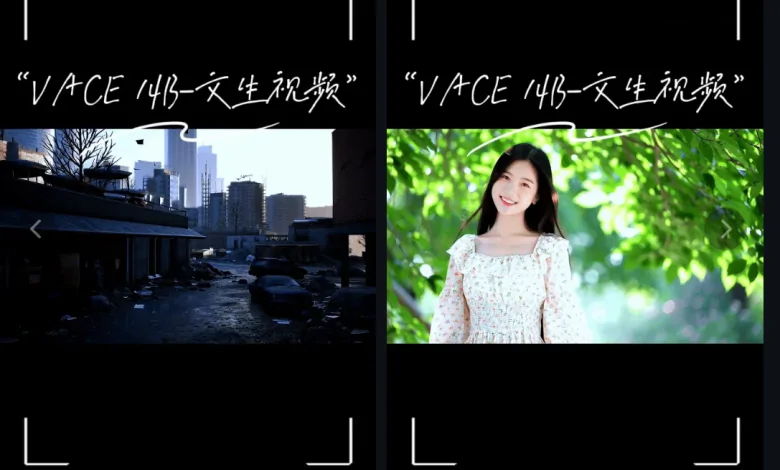VACE 14B Text-to-Video (Automatic Prompt Expansion) – Technical Implementation and Optimization Strategies

Step 1: Resolution Ratio Configuration Deep Dive
The resolution selection interface employs a hybrid numeric-symbolic system to balance user flexibility and technical constraints. Number 0 (custom mode) enforces a 832-pixel width/height cap to align with common video codec limitations, while presets 1-5 abstract aspect ratio standards across platforms:
1:1 (Square): Optimized for Instagram feeds and thumbnail generation, auto-centers subjects via foveated rendering.
3:4 (Vertical): Ideal for TikTok/Reels, with dynamic cropping safeguards to prevent heads from exiting frame.
4:3 (Horizontal Retro): Emulates CRT displays through scanline simulation and chromatic aberration filters.
9:16 (Cinema Wide): Implements anamorphic lens distortion modeling for cinematic depth effects.
16:9 (Vertical Adaptive): Specialized for TikTok’s “vertical cinema” mode, with subtitle-safe zone markers.
Step 2: Frame Rate Engineering
The 16×N frame rate logic derives from GPU memory page alignment requirements. Each frame consumes (width×height×3 bytes) for RGB data, plus 128KB overhead for motion metadata. Key calculations:
VRAM Allocation Formula:
Required VRAM (GB) = (Frames × Resolution × 3) / 1e9 + 0.128 × Frames
4K Workflow: At 3840×2160, 24fps requires ~22GB VRAM – approaching consumer GPU limits.
Adaptive Sampling: For variable-duration videos, the system auto-adjusts frame intervals using a Fibonacci sequence to minimize judder.
Step 3: Semantic Prompt Processing Architecture
The text input undergoes a multi-stage linguistic pipeline:
Tokenization: Splits keywords into 3 categories – entities, attributes, environments.
ConceptNet Embedding: Maps terms to knowledge graph nodes for contextual validation.
Style Transfer: Applies pretrained transformers for artistic styles (e.g., “Japanese-style” → Studio Ghibli aesthetic).
Negative Space Detection: Identifies implicit requirements (e.g., “under a tree” implies outdoor lighting).
Prompt Augmentation: Generates 8 syntactic variants using back-translation across 5 languages, filtered through a CLIP-based relevance score.
Step 4: Execution Workflow Optimizations
The rendering engine implements several acceleration techniques:
Checkpoint Pruning: Deletes intermediate frames with <5% pixel change from adjacent frames.
Batch Processing: Groups similar scenes for matrix multiplication optimization (20-30% speedup).
Fallback Mechanisms: Automatically switches to CPU rendering if VRAM exceeds 95% utilization.
Progressive Rendering: Shows low-res previews at 1/4 resolution during generation, updating every 5% completion.
Advanced Troubleshooting Guide
Timeout Issues: Excessive generation time (>20min) often stems from:
Complex lighting conditions (e.g., “penetrating light spots” requires ray tracing).
High-entropy keywords (e.g., “multicultural crowd” increases simulation complexity).
Memory Leak Prevention:
Clear browser cache before rerunning tasks.
Avoid using VPNs/ad-blockers during generation.
Quality Degradation:
Ensure aspect ratio matches content focus (e.g., avoid 16:9 for vertical portraits).
Use concrete descriptors over abstract terms (“cherry blossoms” > “beautiful scenery”).
Future Development Roadmap
Aspect Ratio AI: Auto-select optimal ratios based on keyword analysis.
4D Video Support: Add z-axis control for parallax effects.
Collaborative Generation: Multi-user prompt blending for creative workflows.
Ethical AI: Watermarking for generated content detection.
This expanded documentation provides a comprehensive technical framework for leveraging VACE 14B’s capabilities, from foundational parameter tuning to advanced troubleshooting and future-proofing strategies. The system’s design emphasizes balancing creative flexibility with technical robustness, catering to both casual users and power developers.
Here is the cloud comfyui which can run workflow online:
https://www.runninghub.ai/post/1922918246369083394/?utm_source=rh-biyird01




